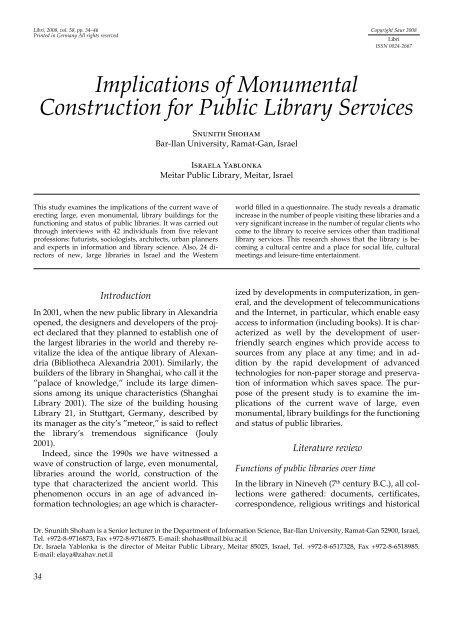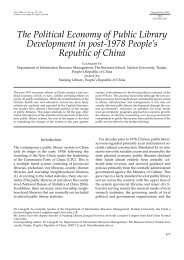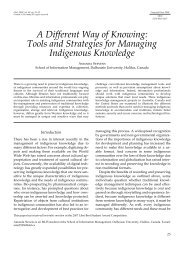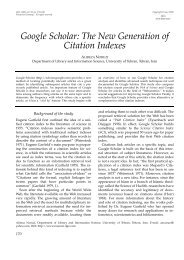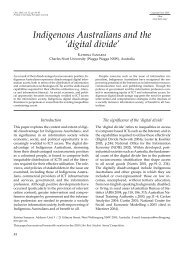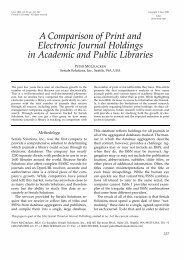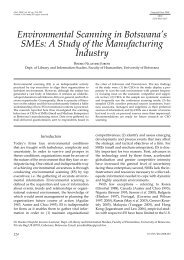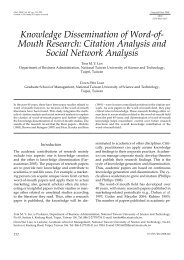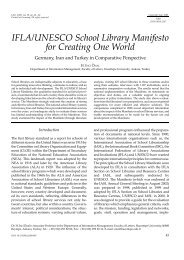Implications of Monumental Construction for Public Library ... - Libri
Implications of Monumental Construction for Public Library ... - Libri
Implications of Monumental Construction for Public Library ... - Libri
Create successful ePaper yourself
Turn your PDF publications into a flip-book with our unique Google optimized e-Paper software.
<strong>Libri</strong>, 2008, vol. 58, pp. 34–46<br />
Printed in Germany All rights reserved<br />
Copyright Saur 2008<br />
<strong>Libri</strong><br />
ISSN 0024-2667<br />
<strong>Implications</strong> <strong>of</strong> <strong>Monumental</strong><br />
<strong>Construction</strong> <strong>for</strong> <strong>Public</strong> <strong>Library</strong> Services<br />
Snunith Shoham<br />
Bar-Ilan University, Ramat-Gan, Israel<br />
Israela Yablonka<br />
Meitar <strong>Public</strong> <strong>Library</strong>, Meitar, Israel<br />
This study examines the implications <strong>of</strong> the current wave <strong>of</strong><br />
erecting large, even monumental, library buildings <strong>for</strong> the<br />
functioning and status <strong>of</strong> public libraries. It was carried out<br />
through interviews with 42 individuals from five relevant<br />
pr<strong>of</strong>essions: futurists, sociologists, architects, urban planners<br />
and experts in in<strong>for</strong>mation and library science. Also, 24 directors<br />
<strong>of</strong> new, large libraries in Israel and the Western<br />
world filled in a questionnaire. The study reveals a dramatic<br />
increase in the number <strong>of</strong> people visiting these libraries and a<br />
very significant increase in the number <strong>of</strong> regular clients who<br />
come to the library to receive services other than traditional<br />
library services. This research shows that the library is becoming<br />
a cultural centre and a place <strong>for</strong> social life, cultural<br />
meetings and leisure-time entertainment.<br />
Introduction<br />
In 2001, when the new public library in Alexandria<br />
opened, the designers and developers <strong>of</strong> the project<br />
declared that they planned to establish one <strong>of</strong><br />
the largest libraries in the world and thereby revitalize<br />
the idea <strong>of</strong> the antique library <strong>of</strong> Alexandria<br />
(Bibliotheca Alexandria 2001). Similarly, the<br />
builders <strong>of</strong> the library in Shanghai, who call it the<br />
”palace <strong>of</strong> knowledge,” include its large dimensions<br />
among its unique characteristics (Shanghai<br />
<strong>Library</strong> 2001). The size <strong>of</strong> the building housing<br />
<strong>Library</strong> 21, in Stuttgart, Germany, described by<br />
its manager as the city’s ”meteor,” is said to reflect<br />
the library’s tremendous significance (Jouly<br />
2001).<br />
Indeed, since the 1990s we have witnessed a<br />
wave <strong>of</strong> construction <strong>of</strong> large, even monumental,<br />
libraries around the world, construction <strong>of</strong> the<br />
type that characterized the ancient world. This<br />
phenomenon occurs in an age <strong>of</strong> advanced in<strong>for</strong>mation<br />
technologies; an age which is characterized<br />
by developments in computerization, in general,<br />
and the development <strong>of</strong> telecommunications<br />
and the Internet, in particular, which enable easy<br />
access to in<strong>for</strong>mation (including books). It is characterized<br />
as well by the development <strong>of</strong> userfriendly<br />
search engines which provide access to<br />
sources from any place at any time; and in addition<br />
by the rapid development <strong>of</strong> advanced<br />
technologies <strong>for</strong> non-paper storage and preservation<br />
<strong>of</strong> in<strong>for</strong>mation which saves space. The purpose<br />
<strong>of</strong> the present study is to examine the implications<br />
<strong>of</strong> the current wave <strong>of</strong> large, even<br />
monumental, library buildings <strong>for</strong> the functioning<br />
and status <strong>of</strong> public libraries.<br />
Literature review<br />
Functions <strong>of</strong> public libraries over time<br />
In the library in Nineveh (7 th century B.C.), all collections<br />
were gathered: documents, certificates,<br />
correspondence, religious writings and historical<br />
Dr. Snunith Shoham is a Senior lecturer in the Department <strong>of</strong> In<strong>for</strong>mation Science, Bar-Ilan University, Ramat-Gan 52900, Israel,<br />
Tel. +972-8-9716873, Fax +972-8-9716875. E-mail: shohas@mail.biu.ac.il<br />
Dr. Israela Yablonka is the director <strong>of</strong> Meitar <strong>Public</strong> <strong>Library</strong>, Meitar 85025, Israel, Tel. +972-8-6517328, Fax +972-8-6518985.<br />
E-mail: elaya@zahav.net.il<br />
34
<strong>Implications</strong> <strong>of</strong> <strong>Monumental</strong> <strong>Construction</strong> <strong>for</strong> <strong>Public</strong> <strong>Library</strong> Services<br />
descriptions, as well as works in various scientific<br />
fields. Hessel (1955) claims that these collections<br />
effectively declare the purpose <strong>of</strong> establishment <strong>of</strong><br />
the library, to serve the state, to glorify the eternal<br />
memory <strong>of</strong> its founder and also <strong>for</strong> science. Since<br />
those distant days, libraries have assumed a variety<br />
<strong>of</strong> <strong>for</strong>ms but their primary, ”classical” function<br />
as guardians <strong>of</strong> the collective memory <strong>of</strong> human<br />
culture has remained unchanged from their<br />
earliest development until today. Over the years,<br />
another central function has been added: not only<br />
do libraries collect and preserve in<strong>for</strong>mation, but<br />
also they now routinely process and disseminate<br />
new in<strong>for</strong>mation. This change occurred gradually,<br />
beginning with the introduction <strong>of</strong> paper (in the<br />
11 th –12 th centuries) and the invention <strong>of</strong> the printing<br />
press (in the 15 th century) and climaxed in the<br />
20 th century. This development occurred simultaneously<br />
with the continued strengthening <strong>of</strong> libraries’<br />
position as public institutions with a<br />
social-education function <strong>of</strong> the utmost importance<br />
(Shoham 1984).<br />
Throughout the 150 years <strong>of</strong> its existence, the<br />
modern public library has undergone changes in<br />
its goals and functions, and as a result in the services<br />
it <strong>of</strong>fers the public. During each period, it<br />
attempted to meet the demands <strong>of</strong> the times. Since<br />
the latter half <strong>of</strong> the 19 th century, libraries have<br />
become a part <strong>of</strong> the public sector and are funded<br />
by public monies. There<strong>for</strong>e, they not only protect<br />
and preserve the knowledge that belongs to the<br />
community, but also have added services intended<br />
<strong>for</strong> the general public, in order to make education<br />
available not only to elites and academics (Shoham<br />
1984).<br />
Initially, the library was an auxiliary institution<br />
in the field <strong>of</strong> education, a continuation <strong>of</strong>, and<br />
supplement to, the public schools that were established<br />
during the same period. As an adaptive<br />
institution, its functions have changed with the<br />
times. There<strong>for</strong>e, in the late 19 th century, the public<br />
library moved into the field <strong>of</strong> leisure and<br />
began <strong>of</strong>fering popular books <strong>for</strong> pleasure reading<br />
or folklore evenings, following the waves <strong>of</strong> immigration<br />
at the time. Furthermore, in the 1950s<br />
and 1960s, the library began to serve as an in<strong>for</strong>mation<br />
centre <strong>for</strong> the general public and fulfilling a<br />
supplementary role by providing in<strong>for</strong>mation services<br />
to public and economic institutions, both<br />
governmental and voluntary (UNESCO Manifesto<br />
1994). In the 1960s and 1970s, libraries began to<br />
participate in social projects and reach out to<br />
various groups <strong>of</strong> non-users.<br />
IFLA (1986) clearly states that other functions<br />
have been added to the library’s traditional role as<br />
a supplier <strong>of</strong> books, because the library has become<br />
a cultural and social centre in the community. As<br />
such, the library <strong>of</strong>fers the community lectures,<br />
clubs, exhibitions, concerts, films, a venue <strong>for</strong> per<strong>for</strong>mances,<br />
the possibility <strong>of</strong> integrating a museum<br />
into the library and even a meeting place <strong>for</strong><br />
different groups, including the elderly (Sannwald<br />
2003). It is almost superfluous to note that in recent<br />
years, libraries have been required to go beyond<br />
their traditional services and adapt themselves to<br />
the in<strong>for</strong>mation revolution by supplying their clients<br />
with new services using advanced technologies<br />
(Dowlin 1993).<br />
However, the IFLA Core Programme (1999) repeatedly<br />
emphasizes and reaffirms the value <strong>of</strong><br />
library collections and archives as vital <strong>for</strong> both<br />
the survival and development <strong>of</strong> culture and<br />
scholarship. It seems that among those working<br />
on the portrait <strong>of</strong> the current and future library,<br />
the voices that tend towards greater emphasis on<br />
social-cultural aspects are increasing.<br />
Vision <strong>of</strong> the virtual library versus the reality <strong>of</strong><br />
the monumental library<br />
Many people would claim that the future has already<br />
arrived. Not only have the needs <strong>of</strong> in<strong>for</strong>mation<br />
consumers changed significantly, but<br />
most importantly, the variety <strong>of</strong> means and possibilities<br />
<strong>for</strong> obtaining in<strong>for</strong>mation have changed.<br />
It is hard to imagine the library’s clients continuing<br />
waiting <strong>for</strong> a busy librarian to supply traditional<br />
service when they have not only telephone, facsimile<br />
and e-mail at their disposal, but also a home<br />
computer or laptop which can be used to connect<br />
directly to the Internet (Denton 1994). Young<br />
people tend to position the library as a marginal<br />
institution in future society and expect that it will<br />
become sort <strong>of</strong> a museum <strong>for</strong> ”antique” materials<br />
(Benton Foundation 1996).<br />
Awareness <strong>of</strong> the possibility that libraries might<br />
disappear is evident in almost every treatment <strong>of</strong><br />
the issue. For example, in their book The Incredible<br />
Vanishing <strong>Library</strong>, Gross and Borgman (1995) describe<br />
the importance <strong>of</strong> the library both as a social<br />
institution and as an organization that supplies<br />
in<strong>for</strong>mation from various sources (books or<br />
35
Snunith Shoham and Israela Yablonka<br />
computer). However, they claim that decision<br />
makers do not sufficiently understand and acknowledge<br />
the great importance <strong>of</strong> the library in<br />
fulfilling these roles and, there<strong>for</strong>e, they are<br />
gradually becoming an invisible institution.<br />
Hage (1999) believes that the basic tools used<br />
by libraries will remain unchanged despite the<br />
advanced technology. A similar line <strong>of</strong> argument is<br />
taken by Schement (1996), who believes that even<br />
in the digital age, the role <strong>of</strong> librarians as skilled<br />
mediators between in<strong>for</strong>mation and the public<br />
should be maintained since most people lack the<br />
skills to navigate between the many sources <strong>of</strong><br />
in<strong>for</strong>mation. Despite this, Schement does consider<br />
the possibility <strong>of</strong> the vanishing library realistic<br />
and believes that librarians should also provide<br />
”remote” in<strong>for</strong>mation services outside <strong>of</strong> the library<br />
building.<br />
As early as 1972, almost 20 years be<strong>for</strong>e the trend<br />
towards building new, large libraries began, Rohlf<br />
(1972) claimed that public libraries would not only<br />
continue to exist and expand the variety <strong>of</strong> services<br />
they <strong>of</strong>fer, but also grow in size. Architects, Rohlf<br />
claimed, are currently required to plan libraries<br />
with a long-term vision and create buildings that<br />
are capable <strong>of</strong> adapting to developments and<br />
changes, house large quantities <strong>of</strong> electronic<br />
gadgetry, while at the same time being filled with<br />
light, space and having a layout that gives people<br />
a feeling <strong>of</strong> belonging and humanity.<br />
In the face <strong>of</strong> all <strong>of</strong> the predictions <strong>of</strong> a world<br />
without books and without libraries, Naisbitt<br />
and Aburdene (1999, 72) claim, ”In every place<br />
where the in<strong>for</strong>mation economy has spread… the<br />
need <strong>for</strong> arts, new museums, cultural and literary<br />
renewal has experienced unprecedented growth.”<br />
The authors even present data showing that more<br />
new titles and new editions <strong>of</strong> books are published<br />
in the United States every year.<br />
A similar spirit <strong>of</strong> wonder, it appears, rests on<br />
most representatives <strong>of</strong> the large libraries that<br />
were constructed or expanded in the late 20 th Century.<br />
Beyond the superlatives used to describe the<br />
buildings themselves, most <strong>of</strong> the library directors<br />
refer to the close connection between the<br />
rejuvenation <strong>of</strong> the library’s visual aspect and its<br />
content and popularity level.<br />
For example, the directors <strong>of</strong> the new public library<br />
in Rotterdam (Meijer 1999), the new library<br />
in Stuttgart, Germany (Jouly 2001), the new<br />
Queens Borough <strong>Public</strong> <strong>Library</strong>, New York (Strong<br />
2001) and the new library <strong>of</strong> San Antonio, Texas<br />
(Zapatos 2000) all describe the impressive building<br />
as one <strong>of</strong> the city’s outstanding landmarks and<br />
note an increase in the number <strong>of</strong> visitors and<br />
users <strong>of</strong> library services.<br />
Do these changes in the character and image <strong>of</strong><br />
the public library help strengthen and preserve its<br />
original goals and will they, in the future, position<br />
it as an institution with a central role in society?<br />
The purpose <strong>of</strong> this study is to attempt to clarify<br />
these issues.<br />
Research questions<br />
Methodology<br />
1. Does the change in a library building have<br />
implications <strong>for</strong> its popularity? In other words, is<br />
there a significant increase in the number <strong>of</strong> visitors<br />
and users to monumental library buildings?<br />
2. Is the change in the <strong>for</strong>m <strong>of</strong> library buildings<br />
indeed being accompanied by a change in content?<br />
In other words, in the new public library, is<br />
it possible to identify a change in direction, trans<strong>for</strong>ming<br />
it from an institution that focuses on ”traditional”<br />
services (circulation, reference, guidance)<br />
into a significant cultural centre in the community<br />
and society (Naisbitt & Aburdene 1990)?<br />
Research Population<br />
The research population included:<br />
A. Directors <strong>of</strong> 24 libraries in Israel and other<br />
Western countries (Western Europe and North<br />
America), whose libraries meet two criteria:<br />
1. The library was built and opened to the public after<br />
1990.<br />
2. The library could be included in the category <strong>of</strong> monumental<br />
structures. To meet these criteria, the study included<br />
libraries in Israel with a constructed area <strong>of</strong><br />
more than 2,000 square meters and libraries in other<br />
countries that are five or more stories tall or cover an<br />
area <strong>of</strong> 10,000 meters square or more.<br />
Most <strong>of</strong> the large libraries in the study were<br />
opened to the public between 1995 and 2001. Out<br />
<strong>of</strong> the 24 libraries included in the study, 79.2% are<br />
in new buildings and 28.8% are libraries that continue<br />
to function in an old building that has been<br />
expanded (sometimes even doubled).<br />
36
<strong>Implications</strong> <strong>of</strong> <strong>Monumental</strong> <strong>Construction</strong> <strong>for</strong> <strong>Public</strong> <strong>Library</strong> Services<br />
Table 1. Does a Magnificent New <strong>Public</strong> <strong>Library</strong> Building Encourage More People to Visit the <strong>Library</strong>? Comparison between<br />
Groups <strong>of</strong> Interviewees (by percentage)<br />
Pr<strong>of</strong>ession Architects In<strong>for</strong>mation and library Futurists Urban planners Sociologists Total<br />
scientists<br />
Percentage <strong>of</strong> positive<br />
answers<br />
100.0 88.9 77.8 57.1 50.0 77.5<br />
B. In addition, we interviewed 42 people from<br />
five relevant pr<strong>of</strong>essions: nine futurists, seven sociologists,<br />
ten architects, seven urban planners<br />
and nine experts from the fields <strong>of</strong> in<strong>for</strong>mation<br />
and library science.<br />
Research Tools<br />
A. A questionnaire was completed by the directors<br />
<strong>of</strong> the 24 selected libraries.<br />
The purpose <strong>of</strong> the 15-question questionnaire<br />
was to examine the characteristics <strong>of</strong> the people<br />
who use the library services and to see whether<br />
there had been a quantitative increase, in addition<br />
to examining the functioning <strong>of</strong> the public library<br />
through the lens <strong>of</strong> the services that it <strong>of</strong>fers in the<br />
new building and the different ways it is used,<br />
as compared to how it functioned in its previous<br />
building.<br />
B. Structured interviews with 42 experts and a<br />
questionnaire each interviewee was asked to<br />
complete at the end <strong>of</strong> the interview. Analysis <strong>of</strong><br />
the interviews was done according to a qualitative<br />
research approach, while the accompanying questionnaire<br />
was analyzed quantitatively.<br />
The interviews lasted between 30 and 90 minutes.<br />
All <strong>of</strong> the interviews were recorded, with the<br />
consent <strong>of</strong> the interviewees, transcribed and processed<br />
with a long process <strong>of</strong> summarization and<br />
adaptation <strong>of</strong> the statements to categories relevant<br />
to the research questions.<br />
Findings<br />
Large buildings – more users?<br />
Can a public library in a magnificent building serve as<br />
a centre <strong>of</strong> attraction?<br />
One <strong>of</strong> the questions asked <strong>of</strong> the experts in<br />
various pr<strong>of</strong>essions was whether, in their opinion,<br />
a magnificent, respectable public library building<br />
would encourage more people to visit the library.<br />
Table 1 presents the division <strong>of</strong> answers given<br />
by the interviewees who answered the question<br />
positively (by percentages), according to pr<strong>of</strong>essional<br />
groups. The data in Table 1 indicate<br />
that most <strong>of</strong> the interviewees (77.5%), including<br />
all <strong>of</strong> the architects and most <strong>of</strong> the in<strong>for</strong>mation<br />
and library scientists and futurists and more than<br />
half <strong>of</strong> the others, indeed believe that a large,<br />
respectable public library building will encourage<br />
more people to visit the library.<br />
Did the number <strong>of</strong> visitors to the library increase?<br />
From the research data we received, it emerges that<br />
after the construction <strong>of</strong> a new library building,<br />
there is a dramatic increase (in percentage) in the<br />
number <strong>of</strong> library visitors. Of the library directors,<br />
96% answered that there had been an increase in<br />
the number <strong>of</strong> visitors. Most responded there was<br />
a 100% increase in the number <strong>of</strong> people visiting<br />
the library, meaning that the number doubled.<br />
Two directors reported an even higher increase.<br />
Was there an increase in the number <strong>of</strong> regular<br />
clients?<br />
Most <strong>of</strong> the libraries that participated in the study<br />
(68.4%) reported that one-fifth <strong>of</strong> the city’s residents<br />
are registered subscribers. Four libraries reported<br />
that over half <strong>of</strong> the residents are registered<br />
as regular users. These numbers represented the<br />
number <strong>of</strong> subscribers registered as regular library<br />
clients. To these numbers, we must add the other,<br />
unregistered residents, who the library, as a public<br />
institution, serves with a variety <strong>of</strong> services that<br />
do not require registration.<br />
All <strong>of</strong> the libraries, except one, reported a significant<br />
increase in the number <strong>of</strong> registered clients.<br />
From the data that we received, it emerges that<br />
the average increase in the number <strong>of</strong> registered<br />
subscribers at the new large libraries was 95.8%.<br />
37
Snunith Shoham and Israela Yablonka<br />
100<br />
80<br />
60<br />
40<br />
20<br />
90<br />
77.8<br />
71.4<br />
66.7<br />
42.9<br />
percentage<br />
0<br />
architects librarians urban<br />
planners<br />
futurists<br />
sociologists<br />
Figure 1: Division, by Pr<strong>of</strong>essional Group, <strong>of</strong> Positive Answers Regarding the <strong>Library</strong> Placement in the City’s Social-Cultural<br />
Center<br />
This means that the number <strong>of</strong> regular clients increased<br />
by the same amount as the number <strong>of</strong><br />
visitors to the library.<br />
From these findings, it clearly appears that the<br />
construction <strong>of</strong> a large library building increases<br />
the number <strong>of</strong> people who use the library whether<br />
they come to visit, surf the Internet or even just to<br />
be with people. Furthermore, it increases the percentage<br />
<strong>of</strong> regular customers who take advantage<br />
<strong>of</strong> the services <strong>of</strong>fered by the public library.<br />
Functions <strong>of</strong> the public library in the virtual age<br />
The library as a centre <strong>of</strong> social-cultural life in the<br />
city<br />
Experts in various pr<strong>of</strong>essions were asked to express<br />
their position regarding the library as a social-cultural<br />
centre. Figure 1 presents the percentage<br />
<strong>of</strong> respondents who believe the library is<br />
a centre <strong>for</strong> social-cultural activity in city. It shows<br />
that 90% <strong>of</strong> the architects would locate the library<br />
in the centre <strong>of</strong> a city’s social and cultural life.<br />
They are followed by the in<strong>for</strong>mation and library<br />
scientists and urban planners. Only 42.9% <strong>of</strong> the<br />
sociologists believe that a library needs to be in<br />
the centre <strong>of</strong> social or cultural life in the city. Most<br />
<strong>of</strong> the interviewees (71.4%) believed that libraries<br />
should be in the social-cultural centre <strong>of</strong> the<br />
city.<br />
Roles <strong>of</strong> the public library in the 21 st century –<br />
analysis <strong>of</strong> the interviews<br />
After we learned about the interviewees’ opinions<br />
regarding the public library and its location in the<br />
centre <strong>of</strong> the city’s social and cultural activity, we<br />
continued by asking what, in the interviewees<br />
opinions, should be the library’s role in future society.<br />
In<strong>for</strong>mation and library scientists<br />
After analyzing the statements by the interviewees<br />
from the field <strong>of</strong> in<strong>for</strong>mation and library science<br />
regarding this question, it emerges that all members<br />
<strong>of</strong> this group agreed on one function: the library<br />
is a place <strong>for</strong> holding cultural activities and<br />
a meeting place <strong>for</strong> spending leisure time. ”We<br />
are a society that is built on personal meetings …<br />
some <strong>of</strong> the readers have a limited need <strong>for</strong> the<br />
collection … they come in order to meet … there<strong>for</strong>e<br />
the place is lively … (V.B.). ”The library <strong>of</strong> the<br />
21 st century is a social meeting place … beyond<br />
this, the library needs to allow <strong>for</strong> clubs and generally<br />
be a cultural centre” (B.L.).<br />
Regarding other library functions, approximately<br />
one-half <strong>of</strong> the interviewees from this group<br />
said that the library should be a place to learn and<br />
acquire skills, in addition to locating the necessary<br />
in<strong>for</strong>mation. ”The library is a place to sit and do<br />
homework, a place to study…” (S.H.). ”The library<br />
has a very important role in acquiring the<br />
skills <strong>for</strong> locating and processing knowledge and<br />
in<strong>for</strong>mation… it has a role in developing taste in<br />
reading and encouraging reading” (M.R.).<br />
There are those who connect the public library’s<br />
instructional function with its democratic function:<br />
providing equal opportunity <strong>for</strong> every one to<br />
access in<strong>for</strong>mation. ”In the 21 st century it is important<br />
that the library instruction teach the use <strong>of</strong><br />
computer and Internet – to reduce the digital gap”<br />
(S.B.). Only two <strong>of</strong> the in<strong>for</strong>mation and library scientists<br />
interviewed mentioned the traditional functions<br />
<strong>of</strong> the public library – preserving knowledge<br />
38
<strong>Implications</strong> <strong>of</strong> <strong>Monumental</strong> <strong>Construction</strong> <strong>for</strong> <strong>Public</strong> <strong>Library</strong> Services<br />
and lending books. Perhaps these things seem to<br />
be self-evident.<br />
Architects<br />
The function <strong>of</strong> the public library all <strong>of</strong> the architects<br />
agreed upon and mentioned was social<br />
meeting. ”<strong>Library</strong> is like a house <strong>of</strong> prayer – these<br />
are buildings where large numbers <strong>of</strong> people gather”<br />
(Y.G.). The library has a role in preserving<br />
books and also in bringing together resources in<br />
all existing media. Most <strong>of</strong> the architects agreed on<br />
this point. ”Practically speaking, a library is ‘a museum<br />
<strong>of</strong> knowledge,’ a warehouse <strong>of</strong> in<strong>for</strong>mation<br />
<strong>for</strong> coming generations … on paper and on electronics”<br />
(M.K.).<br />
Urban Planners<br />
This group had many doubts and there was not<br />
even a single function mentioned by all members<br />
<strong>of</strong> this group. Despite this, most <strong>of</strong> the urban planners<br />
interviewed noted that in the future the library<br />
would be a place <strong>for</strong> preservation or storage,<br />
but with the possibility <strong>of</strong> accessing this preserved<br />
material. ”First <strong>of</strong> all, preservation <strong>for</strong> future generations<br />
is necessary … but also presentation, to<br />
make all <strong>of</strong> the literature accessible and visual …”<br />
(A.L.).<br />
Sociologists<br />
In this group, too, there was no agreement regarding<br />
the main purpose <strong>of</strong> the library. However,<br />
most <strong>of</strong> the sociologists interviewed think that the<br />
library must make in<strong>for</strong>mation broadly available<br />
on a full range <strong>of</strong> media. ”First <strong>of</strong> all, a centre <strong>of</strong><br />
knowledge, a centre that facilitates access to knowledge<br />
…” (S.N.). There were those who made a connection<br />
between libraries’ <strong>of</strong>ferings and equality<br />
in society. ”This is in the context <strong>of</strong> people who do<br />
not have the means to purchase all <strong>of</strong> the books …<br />
to provide in<strong>for</strong>mation at no cost” (S.K.). Of the<br />
sociologists, three noted that libraries should continue<br />
their traditional functions <strong>of</strong> ”lending, reading,<br />
guidance and reference” (Z.Z.).<br />
Futurists<br />
Most <strong>of</strong> the futurists interviewed do not consider<br />
the public library an essential institution, because<br />
<strong>of</strong> the technological changes that have already occurred<br />
and which are continuing to occur. However,<br />
when we asked what, despite this, roles <strong>of</strong> a<br />
library would have in the future society, several <strong>of</strong><br />
the interviewees mention the role <strong>of</strong> the library as<br />
a meeting place and also the necessity <strong>of</strong> a place<br />
that will gather and organize in<strong>for</strong>mation and be<br />
responsible <strong>for</strong> preserving the culture. Several <strong>of</strong><br />
the people interviewed referred to the role <strong>of</strong> the<br />
library in providing pr<strong>of</strong>essional instruction and<br />
assisting the educational system.<br />
The public library will not remain a source <strong>of</strong> in<strong>for</strong>mation –<br />
that’s over, but it will have other functions such as<br />
meetings with books, meeting to exchange in<strong>for</strong>mation…<br />
people need the social interaction and everyone looks <strong>for</strong><br />
an appropriate place. People are looking <strong>for</strong> a reason to<br />
meet. Some meet in a restaurant, others in a movie theatre,<br />
others in their living room and yet others in a library.<br />
(A.A.)<br />
Functions <strong>of</strong> the public library in the opinion <strong>of</strong> all<br />
groups (analysis <strong>of</strong> questionnaires)<br />
1) Functions <strong>of</strong> the public library in the opinion <strong>of</strong><br />
all respondents.<br />
Table 2 presents rankings <strong>of</strong> the public library functions<br />
according to the opinions <strong>of</strong> all participants<br />
in the study. We found that a majority <strong>of</strong> the participants<br />
think that a public library should be a<br />
place <strong>for</strong> study and research. Other functions<br />
noted were, in descending order, provision <strong>of</strong> reference<br />
services, cultural preservation, providing<br />
educational videos and reading books and being<br />
a cultural centre. Furthermore, it should be noted<br />
that only three-quarters <strong>of</strong> the futurists assigned<br />
any function to libraries in the future, consistently<br />
claiming that there will be no need <strong>for</strong> the public<br />
libraries and they will have no function in the future<br />
society.<br />
2) Functions <strong>of</strong> the public library – comparison <strong>of</strong><br />
the interview groups.<br />
Examination <strong>of</strong> Table 2 reveals that differences exist<br />
between the perceptions that members <strong>of</strong> different<br />
pr<strong>of</strong>essions have regarding public libraries.<br />
All (100%) <strong>of</strong> the sociologists and architects think<br />
that the libraries’ traditional functions, providing<br />
books <strong>for</strong> reading and reference, are most important,<br />
compared to only 44.4% <strong>of</strong> the futurists<br />
who indicated that these would be among the public<br />
library functions in the future. The sociologists<br />
added that the library also functions to preserve<br />
the culture and serve as a cultural centre that <strong>of</strong>fers<br />
lecturers, cultural events, etc.<br />
39
Snunith Shoham and Israela Yablonka<br />
Table 2. Functions <strong>of</strong> the <strong>Library</strong> – Comparison between Pr<strong>of</strong>essional Groups (in percentages)<br />
<strong>Library</strong> function<br />
Futurists* Sociologists Architects Urban planners In<strong>for</strong>mation and library<br />
science<br />
<strong>Library</strong><br />
directors<br />
1 Reading 44.4 100.0 100.0 71.4 88.9 95.8 81.0<br />
2 Reference 44.4 100.0 100.0 85.7 100.0 91.7 85.7<br />
3 Study place 77.8 100.0 90.0 85.7 88.9 95.8 88.1<br />
4 Newspapers 44.4 85.7 90.0 57.1 100.0 91.7 76.2<br />
5 Educational video 55.6 85.7 100.0 71.4 100.0 82.3 82.3<br />
6 Entertainment video 44.4 85.7 90.0 57.1 77.8 87.5 71.4<br />
7 In<strong>for</strong>mation center 66.7 85.7 80.0 28.6 88.9 75.0 71.4<br />
8 Communications 33.3 71.4 100.0 42.9 66.7 70.8 64.3<br />
center<br />
9 Cultural center 44.4 100.0 90.0 85.7 88.9 95.8 81.0<br />
10 <strong>Public</strong> clubs 44.4 57.1 90.0 57.1 77.8 87.5 66.7<br />
11 Leisure activities 55.6 85.7 80.0 71.4 100.0 100.0 70.6<br />
12 Meeting <strong>of</strong> distinctive 33.3 71.4 60.0 42.9 88.9 66.7 59.5<br />
groups<br />
13 Attraction <strong>for</strong> visitors 22.2 57.1 50.0 28.6 55.6 66.7 42.9<br />
14 Cultural preservation 66.7 100.0 90.0 100.0 77.8 70.8 85.7<br />
15 Archive 66.7 85.7 70.0 85.7 33.3 54.2 66.7<br />
*Approximately one-quarter <strong>of</strong> the futurists refused to answer the question regarding functions, claiming that the library has no<br />
future.<br />
Total<br />
People interviewed from the field <strong>of</strong> in<strong>for</strong>mation<br />
and library science responded that the most important<br />
functions are to supply reference materials<br />
as well as being a place <strong>for</strong> recreation and leisure.<br />
In contrast, the urban planners gave greater<br />
weight to the role <strong>of</strong> cultural preservation, while<br />
the futurists apparently considered the public library’s<br />
functions less important <strong>for</strong> future societies.<br />
To determine if there are significant differences<br />
between the different pr<strong>of</strong>essional groups on the<br />
question <strong>of</strong> public library functions, χ 2 analysis<br />
was done. This analysis found that there were significant<br />
differences regarding several functions:<br />
Regarding the library’s function as a provider <strong>of</strong><br />
reading books, it was found that all <strong>of</strong> the sociologists,<br />
architects and interviewees from the<br />
field <strong>of</strong> in<strong>for</strong>mation and library science thought<br />
that this is an important function, in comparison<br />
to the futurists who thought otherwise: χ ² = 12.56,<br />
p < .05.<br />
Regarding the function <strong>of</strong> the library as a supplier<br />
<strong>of</strong> reference books and encyclopaedias, we<br />
found that all <strong>of</strong> the people interviewed from the<br />
field <strong>of</strong> in<strong>for</strong>mation and library science, architects<br />
and sociologist thought that this function is important,<br />
unlike the futurists: χ ² = 16.85, p
Table 3: <strong>Library</strong> Functions (Desirable) Compared to Services Actually Provided (Actual)<br />
<strong>Library</strong> Function<br />
<strong>Implications</strong> <strong>of</strong> <strong>Monumental</strong> <strong>Construction</strong> <strong>for</strong> <strong>Public</strong> <strong>Library</strong> Services<br />
Desirable<br />
%<br />
Actual<br />
%<br />
Wilcoxon<br />
Place <strong>for</strong> leisure activity 100.0 78.2 0.02*<br />
Reading books 95.8 95.8 1.00<br />
Plays <strong>for</strong> study or research 95.8 71.7 0.16<br />
Cultural center 95.8 79.2 0.04*<br />
Reference books 91.7 91.7 1.00<br />
Local and international newspapers 91.7 79.2 0.18<br />
Video and audio – <strong>for</strong> pleasure 87.5 79.2 0.32<br />
<strong>Public</strong> clubs 87.5 75.0 0.08*<br />
Video and audio – educational 83.3 75.0 0.41<br />
<strong>Public</strong> in<strong>for</strong>mation center 75.0 62.5 0.18<br />
<strong>Public</strong> communication center – Internet 70.8 75.0 0.56<br />
Cultural preservation 70.8 66.7 0.32<br />
Meeting place <strong>for</strong> distinctive groups 66.7 58.3 0.32<br />
Attractive place <strong>for</strong> visitors 66.7 62.5 0.56<br />
Archive <strong>for</strong> storing existing collections 54.2 45.8 0.32<br />
* p< .05<br />
sociologists, architects, urban planners and interviewees<br />
from the field <strong>of</strong> in<strong>for</strong>mation and library<br />
science, in comparison to the futurists: χ ² = 10.43,<br />
p < .05.<br />
3) Functions <strong>of</strong> the public library in the opinion <strong>of</strong><br />
library directors<br />
From the data in Table 2 it is possible to see that<br />
all <strong>of</strong> the library directors who participated in<br />
this study included serving as a place <strong>for</strong> leisure<br />
time activities in the library functions. Three additional<br />
functions: providing reading books, a<br />
place <strong>for</strong> study and research and serving as a cultural<br />
centre were also noted by 95.9% <strong>of</strong> the<br />
library directors. Over 90% <strong>of</strong> library directors included<br />
the provision <strong>of</strong> local and international<br />
newspapers and reference books in their list <strong>of</strong><br />
library functions.<br />
The library directors expressed less support <strong>for</strong><br />
several <strong>of</strong> the functions, including serving as a<br />
place <strong>for</strong> unique groups to meet, an attractive place<br />
<strong>for</strong> tourists, the functioning to preserve the culture<br />
and being a centre <strong>for</strong> Internet communications.<br />
When comparing the responses <strong>of</strong> library directors<br />
in Israel to those from abroad, we did<br />
not find any significant differences <strong>for</strong> any <strong>of</strong> the<br />
functions presented.<br />
It should be noted that there were library directors<br />
who added functions that were not included<br />
among the options presented on the<br />
questionnaire. In particular, they emphasized instructional<br />
functions. In their opinion, the public<br />
library plays an active role in education, instruction<br />
and nurturing reading.<br />
<strong>Public</strong> library functions: or has the external<br />
change been accompanied by a change <strong>of</strong> content?<br />
After we examined the functions <strong>of</strong> the library,<br />
in the opinion <strong>of</strong> all interview groups, as well as<br />
the library directors, we attempted to learn what<br />
was actually happening inside the libraries, which<br />
services they are providing in the new buildings<br />
that were opened in the last decade and which <strong>of</strong><br />
these services were not provided previously, in the<br />
old building.<br />
The public library and its services to the public:<br />
the desirable versus actual (analysis <strong>of</strong> the<br />
questionnaire <strong>for</strong> library directors)<br />
From the library directors, we attempted to learn<br />
what is actually happening within the libraries,<br />
what services they provide in comparison to the<br />
services that are, in their opinion, desirable.<br />
41
Snunith Shoham and Israela Yablonka<br />
Table 3 presents the desired functions compared<br />
to the actual functions, those that are actually<br />
being provided by the libraries.<br />
The services that are actually being provided: From<br />
the table, it emerges that two <strong>of</strong> the services<br />
were indicated by most <strong>of</strong> the library directors,<br />
more than 90%, are traditional library services:<br />
providing books <strong>for</strong> reading and reference books.<br />
Slightly less than 80% <strong>of</strong> the library directors indicated<br />
that their libraries supply local and international<br />
newspapers, video and audio recordings<br />
<strong>for</strong> pleasure and that their library is a cultural<br />
centre <strong>for</strong> lectures, exhibitions, etc. or serves as<br />
a locale <strong>for</strong> leisure activities. Fewer than half <strong>of</strong><br />
the libraries included in the study also serve as an<br />
archive.<br />
It should be noted that most <strong>of</strong> the libraries<br />
claimed that the library is egalitarian and democratic,<br />
yet the table shows that only 58.3% <strong>of</strong> the<br />
libraries provide services <strong>for</strong> distinctive groups<br />
with special needs in their community.<br />
Again, there were librarians that chose to add<br />
services which, in their opinion, are important, but<br />
were not included in the possibilities listed on the<br />
questionnaire: virtual library services, the ability to<br />
access library databases without necessarily being<br />
present in the library but rather over the Internet,<br />
developing early childhood reading, purchasing<br />
and maintaining a large collection including antique<br />
books and museums, access to electronic data<br />
<strong>for</strong> the business community, special services <strong>for</strong><br />
adolescents, and renting library rooms/halls.<br />
Table 3 shows a sweeping difference between<br />
desirable and the actual. The library directors<br />
think that the library ought to fill many important<br />
functions but in actual practice, the libraries <strong>of</strong>fer<br />
the public fewer services than their directors believe<br />
would be desirable.<br />
Regarding traditional library functions – the provision<br />
<strong>of</strong> reading books <strong>for</strong> lending and serving as<br />
a reference room – there is a correlation between<br />
the services that libraries are supposed to provide<br />
the public and what they actually provide. For all<br />
<strong>of</strong> the other possible library functions included on<br />
the list, except providing Internet, more library directors<br />
indicated that the possibility was part <strong>of</strong> a<br />
library’s desirable functions than actually provide<br />
that service to the public in their library.<br />
All <strong>of</strong> the library directors (100%) believe that<br />
one <strong>of</strong> the library’s functions is to serve as a cultural<br />
centre <strong>for</strong> leisure time activities, yet only<br />
78.2% open their doors <strong>for</strong> leisure time activities.<br />
Similarly, 95.8% think that the library building<br />
should serve as a home <strong>for</strong> cultural events such as<br />
lectures, exhibitions, per<strong>for</strong>mances, thereby serving<br />
as a municipal culture centre, but only 79.2%<br />
allow this type <strong>of</strong> activity. Likewise, 87.5% <strong>of</strong> the<br />
library directors indicated it would be desirable<br />
<strong>for</strong> the library to serve as a place <strong>for</strong> holding club<br />
meetings <strong>for</strong> the general public, yet only 75% <strong>of</strong><br />
the libraries actually <strong>of</strong>fer clubs.<br />
The differences between the desirable and the actual:<br />
To highlight the discrepancy between the desirable<br />
library functions and the actual services provided<br />
by the libraries a nonparametric, Wilcoxon analysis<br />
was conducted. This analysis reveals significant<br />
differences <strong>for</strong> three library functions, as<br />
follows: the library as a cultural centre, holding<br />
club meetings in the library and the public library<br />
as the place <strong>for</strong> leisure time activities. These three<br />
functions express the social need <strong>for</strong> meetings in a<br />
cultural locale, such as the public library. All three<br />
<strong>of</strong> these functions are desired more than they are<br />
actually provided.<br />
New services in the new building<br />
Having examined the opinions <strong>of</strong> library directors,<br />
the functions <strong>of</strong> public libraries and the services<br />
provided by the libraries, we examined whether<br />
new library services, which were not provided in<br />
the previous building, are being provided in the<br />
new building. In other words, has the public library<br />
changed only its external appearance or also<br />
its contents? Does a new, larger building make it<br />
possible to provide services that were not <strong>of</strong>fered<br />
in the old the building?<br />
The library directors were asked to indicate<br />
which <strong>of</strong> the services (listed in Table 4), currently<br />
provided by their library, were not <strong>of</strong>fered by<br />
their library in its old building. Of the 24 library<br />
directors who participated in the study, only 19<br />
answered this question.<br />
The following table presents the distribution <strong>of</strong><br />
the library director answers regarding new services<br />
in their library, in descending order (by percentage).<br />
As the table illustrates, a new library building<br />
makes it possible to <strong>of</strong>fer several new services that<br />
were not available in the library’s old building.<br />
Approximately one-half <strong>of</strong> the libraries reported<br />
that the library now serves as a cultural centre <strong>for</strong><br />
42
<strong>Implications</strong> <strong>of</strong> <strong>Monumental</strong> <strong>Construction</strong> <strong>for</strong> <strong>Public</strong> <strong>Library</strong> Services<br />
lectures, art exhibits, per<strong>for</strong>mances, meetings with<br />
authors, and other events.<br />
Approximately 40% report that they now have<br />
a place <strong>for</strong> reading local and international newspapers<br />
and magazines, that they can provide video<br />
and audio recordings <strong>for</strong> pleasure and that they<br />
can serve as an Internet communications centre.<br />
Approximately one-third <strong>of</strong> the respondents indicated<br />
additional new services: an attractive<br />
place <strong>for</strong> visitors, video and audio recordings <strong>for</strong><br />
educational purposes, public clubs and a place<br />
<strong>for</strong> leisure activity while slightly more than 20%<br />
noted that the new library they manage serves as<br />
a meeting place <strong>for</strong> unique groups, and a similar<br />
percentage said that cultural preservation is one <strong>of</strong><br />
their library’s new functions, which was not possible<br />
in the old building. Only 15% reported that<br />
the library now serves as an archive <strong>for</strong> existing<br />
collection. In this section, too, some library directors<br />
noted additional, new functions that were not<br />
included on the list <strong>of</strong> possible library functions:<br />
virtual services and expanded programs <strong>for</strong><br />
children.<br />
It should be noted that there was no difference<br />
in the responses <strong>of</strong> library directors in Israel and<br />
abroad on this subject.<br />
The responses from the library directors received<br />
clearly indicate that a new, more spacious library<br />
building does allow the library to <strong>of</strong>fer more<br />
services, not necessarily traditional library services,<br />
but rather leisure activities: clubs, exhibitions (rare<br />
book displays), per<strong>for</strong>mances, theatre, space to<br />
read newspapers and magazines.<br />
Discussion<br />
Large buildings – are there more users?<br />
The first research question asked whether the<br />
change in library buildings has implications <strong>for</strong><br />
their popularity. The research findings clearly<br />
show that all <strong>of</strong> the new, large, magnificent buildings<br />
that have been built as public libraries receive<br />
at least twice as many visitors as their predecessors<br />
and there has also been a very significant increase<br />
in the percentage <strong>of</strong> library users and regular<br />
clients. Research conducted among public libraries<br />
in Israel (Yablonka 1998) found a direct connection<br />
between the image <strong>of</strong> the library and its use, both<br />
in terms <strong>of</strong> the number <strong>of</strong> users and the number<br />
<strong>of</strong> books borrowed. The present study shows that<br />
Table 4: New Services in the New Building (percentages)<br />
New services the library <strong>of</strong>fers the public Percentage<br />
Cultural Centre 47.4<br />
Local and international newspapers 42.1<br />
Video and audio recordings – <strong>for</strong> pleasure 42.1<br />
<strong>Public</strong> communication centre – Internet 42.1<br />
Attractive place <strong>for</strong> visitors 36.8<br />
Video and audio recordings – educational 31.6<br />
<strong>Public</strong> clubs 31.6<br />
Place <strong>for</strong> leisure activity 31.6<br />
Place <strong>for</strong> study or research 26.3<br />
<strong>Public</strong> in<strong>for</strong>mation centre 26.3<br />
Meeting place <strong>for</strong> distinctive groups 21.1<br />
Cultural preservation 21.0<br />
Archive <strong>for</strong> storing existing collections 15.8<br />
Reading books 0<br />
Reference books 0<br />
these new buildings have apparently improved<br />
the reputation <strong>of</strong> the library and thereby increased<br />
use.<br />
This finding is very important because many<br />
libraries around the world report a general decrease<br />
in the number <strong>of</strong> readers, the number <strong>of</strong><br />
books borrowed and the number <strong>of</strong> regular clients.<br />
By contrast, it is worth noting the research<br />
conducted by Westin and Finger (1991), which<br />
claims that the number <strong>of</strong> users increases in every<br />
place where a new library was built, regardless <strong>of</strong><br />
size. Their claim is that any change in the library<br />
influences the library’s environment and usage.<br />
There<strong>for</strong>e, they recommend constant revitalization<br />
<strong>of</strong> the library’s image. Yet another perspective is<br />
presented by McCabe (2000) who claims that the<br />
number <strong>of</strong> users increases because a wider variety<br />
<strong>of</strong> services are <strong>of</strong>fered and it is the larger building<br />
that makes the services possible.<br />
<strong>Library</strong> functions in a virtual age<br />
Most interviewees considered it important <strong>for</strong> the<br />
library to be at the centre <strong>of</strong> the social and cultural<br />
life <strong>of</strong> the city. Another function mentioned by most<br />
<strong>of</strong> the interviewees, in most <strong>of</strong> the groups, was<br />
the function <strong>of</strong> gathering, organizing and storing<br />
in<strong>for</strong>mation, as well as making it accessible. All<br />
<strong>of</strong> the people interviewed from the fields <strong>of</strong> in-<br />
43
Snunith Shoham and Israela Yablonka<br />
<strong>for</strong>mation and library science emphasized the<br />
role <strong>of</strong> the library in the field <strong>of</strong> cultural activity<br />
and in facilitating social meetings. All <strong>of</strong> the architects<br />
consider the library a place <strong>for</strong> leisuretime<br />
entertainment. Most <strong>of</strong> the members <strong>of</strong> this<br />
group referred to the library as a democratic,<br />
egalitarian place where social gaps, especially the<br />
digital divide, can be narrowed. They also noted<br />
the role <strong>of</strong> the library in preserving culture,<br />
whether through books or other media. Most <strong>of</strong><br />
the urban planners emphasized the role <strong>of</strong> the library<br />
in preserving existing collections and culture.<br />
Sociologists and futurists did not place special<br />
emphasis on any one function.<br />
The literature deals with the concept <strong>of</strong> the<br />
public library as ”the people’s university,” but in<br />
this study only seven <strong>of</strong> the 42 people interviewed<br />
mentioned this function. Furthermore, when we<br />
presented the library as a place <strong>for</strong> unique populations<br />
in society, this function was given a low<br />
ranking. Sannwald (2003) claims that libraries are<br />
becoming a place <strong>of</strong> social interaction, and research<br />
conducted in the United States (Benton Foundation<br />
1998) found that the most important function <strong>of</strong><br />
the library is to provide access to technology <strong>for</strong><br />
people <strong>of</strong> modest means. Westin and Finger (1991)<br />
stress that the public library should live up to its<br />
name: public and free and there<strong>for</strong>e, by its very<br />
nature, serve as a bridge between knowledge and<br />
all strata <strong>of</strong> the population.<br />
The library’s traditional services (lending and<br />
reference) were mentioned by the experts in in<strong>for</strong>mation<br />
and library science and the architects.<br />
The latter also added the library’s function as a<br />
communications centre that provides access to the<br />
Internet<br />
All <strong>of</strong> the library directors positioned serving as<br />
a place <strong>for</strong> leisure time entertainment as the most<br />
important library function, followed by serving as<br />
a place <strong>for</strong> study, circulation and a cultural centre.<br />
Services <strong>of</strong>fered by public libraries: or has the<br />
external change been accompanied by a change <strong>of</strong><br />
content?<br />
The second research question examined whether<br />
the external change was accompanied by a change<br />
<strong>of</strong> content. Did the large buildings allow changes<br />
in or additions to the services provided by the library?<br />
If so, is it possible to identify a change<br />
that trans<strong>for</strong>med the library from an institution<br />
focuses on providing traditional library services<br />
into a significant cultural centre <strong>for</strong> society and<br />
the community, as emerges from the opinions <strong>of</strong><br />
the interviewees?<br />
As noted in the literature review, public libraries<br />
have shown, throughout their history, the ability to<br />
adjust and adapt to the needs <strong>of</strong> the environment.<br />
Although they began as a municipal service to intellectuals<br />
by providing reference materials, they<br />
quickly opened their doors to the general public,<br />
lending books and <strong>of</strong>fering guidance, to make<br />
knowledge accessible to all. Over the years, collections<br />
have become more varied and services<br />
have been added or changed. Knowledge is now<br />
available both on paper and on digital media,<br />
and the library attempts to provide a response in<br />
both the cultural and social realms. This service<br />
actually began in the late 19 th century (Shoham<br />
1984), when the public library entered the field<br />
<strong>of</strong> leisure by <strong>of</strong>fering popular reading books and<br />
folklore evenings. The leisure field expanded<br />
and libraries also began to <strong>of</strong>fer lectures, clubs,<br />
exhibitions and meeting places <strong>for</strong> different groups<br />
(Sannwald 2003; IFLA 1986). It is interesting to<br />
note that the 1972 UNESCO Manifesto states, ”The<br />
public library is a natural cultural centre <strong>for</strong> the<br />
community, bringing together as it does people …<br />
Space and equipment are there<strong>for</strong>e necessary <strong>for</strong><br />
exhibitions, discussions, lectures, musical per<strong>for</strong>mances<br />
and films …” (UNESCO <strong>Public</strong> <strong>Library</strong><br />
Manifesto 1972) yet the next UNESCO Manifesto,<br />
published in 1994, does not mention the library’s<br />
cultural and social function.<br />
The current study clearly shows that the emphasis<br />
in library functions and services to the<br />
public is shifting to the cultural and social realms.<br />
All <strong>of</strong> the library directors believe the public library<br />
should serve as a place <strong>for</strong> leisure entertainment<br />
and almost all (95.8%) believe the library building<br />
should serve as a municipal cultural centre.<br />
On this issue, all <strong>of</strong> the architects and a majority<br />
<strong>of</strong> the other interviewees repeated that the library<br />
had to serve as ”a meeting place with a cultural<br />
experience.” Most <strong>of</strong> the people interviewed<br />
thought that the public library should be ”a cultural<br />
shopping mall” that serves as a source <strong>of</strong><br />
knowledge <strong>of</strong>fered to the general public. Sociologists<br />
and architects emphasized the guidance and<br />
instructional services <strong>for</strong> finding the necessary<br />
materials, while it was actually the futurists who<br />
placed heavier emphasis on cultural preservation.<br />
44
<strong>Implications</strong> <strong>of</strong> <strong>Monumental</strong> <strong>Construction</strong> <strong>for</strong> <strong>Public</strong> <strong>Library</strong> Services<br />
From library directors’ responses, it emerges<br />
that the most widely accepted services provided<br />
by libraries are traditional services, such as providing<br />
reading and reference materials. We also<br />
found that in almost all cases the desirable<br />
functions exceeded the actual services available.<br />
In three cases there were significant differences<br />
between the desirable than the actual: the library<br />
as a cultural centre, the library as a place <strong>for</strong> leisure<br />
activities and the library as a place that allows<br />
public clubs. These differences reflect the<br />
changes in library services in the society <strong>of</strong> the<br />
future. All <strong>of</strong> the library directors believe that the<br />
most important function <strong>of</strong> the library is to be a<br />
place <strong>of</strong> leisure-time activity, and approximately<br />
96% believe the library should serve as a cultural<br />
centre. Indeed, most <strong>of</strong> the libraries do provide<br />
this service. Approximately one-half <strong>of</strong> the library<br />
directors report that the library as a ”cultural centre”<br />
is a new service that was not provided previously<br />
in their old library and that the move to a<br />
new building has made this possible. This finding<br />
confirms the second research assumption that<br />
where monumental library buildings are built, the<br />
library becomes a social and cultural centre.<br />
Additional services that have been added after<br />
the move to a new building include supplying local<br />
and international newspapers, Internet communications<br />
centre, collections <strong>of</strong> local and international<br />
newspapers and viewing and borrowing<br />
movies <strong>for</strong> pleasure.<br />
Conclusions<br />
The current study regards the future <strong>of</strong> public libraries<br />
in the world that is changing be<strong>for</strong>e our<br />
eyes. The names <strong>of</strong> library institutions have<br />
changed during recent years. In many places the<br />
word ”library” has been replaced with ”mediatech”<br />
or ”bibliotech”, after the style <strong>of</strong> ”hi-tech,”<br />
to express the combination <strong>of</strong> books, digital media<br />
and high technology. What is their place in society<br />
and where are they headed? This confusion intensifies<br />
in light <strong>of</strong> the facts on the ground,<br />
which show a significant decrease in reading and<br />
borrowing books, the traditional functions <strong>of</strong> the<br />
library. In contrast to these reports, the current<br />
study reveals a dramatic increase in the number<br />
<strong>of</strong> people visiting new, large libraries and a very<br />
significant increase in the number <strong>of</strong> regular clients<br />
who come to the library to receive services<br />
other than traditional library services. The research<br />
findings show that libraries are becoming<br />
a cultural centre and a place <strong>for</strong> social life, cultural<br />
meetings and leisure-time entertainment.<br />
This research also shows that a new, magnificent<br />
building becomes an attraction in its own right and<br />
greatly increases the percentage <strong>of</strong> the population<br />
that uses the library. It is certainly possible that the<br />
number <strong>of</strong> users increases, because <strong>of</strong> the wider<br />
range <strong>of</strong> services possible because the building is<br />
larger. Expanded building size makes it possible to<br />
hold cultural events, introduce additional, special<br />
materials that could not have been accommodated<br />
in the smaller building and, obviously, a bigger<br />
library can house a larger, more varied collection<br />
that is attractive to many different population<br />
sectors.<br />
The size <strong>of</strong> the public library building makes it<br />
possible to be attentive to the public’s needs and<br />
<strong>of</strong>fer a wide range <strong>of</strong> services: continued traditional<br />
services, access to in<strong>for</strong>mation on a variety <strong>of</strong><br />
media (paper and digital), holding varied cultural<br />
activities, a welcoming, pleasant meeting place<br />
and ”a shrine <strong>of</strong> the book” where humanity’s cultural<br />
legacy is preserved.<br />
The picture outlined by this study shows that<br />
the library will be necessary in the society <strong>of</strong> the<br />
future, less <strong>for</strong> reading and more to meet the public’s<br />
need <strong>for</strong> a relatively quiet, refined place <strong>for</strong><br />
social gatherings with a cultural character. Indeed,<br />
the present research shows that the new buildings<br />
have allowed libraries to become cultural centres<br />
and <strong>of</strong>fer services that have not been possible in<br />
the past or were <strong>of</strong>fered only on a more limited<br />
scale.<br />
References<br />
Benton Foundation. 1998. The future in the balance: A<br />
toolkit <strong>for</strong> libraries and communities in the digital age.<br />
Washington, DC: Benton Foundation.<br />
Benton Foundation. 1996. Buildings, books, and bytes: Libraries<br />
and communities in the digital age. Washington,<br />
DC: Benton Foundation.<br />
Bibliotheca Alexandria. 2001. URL: http:/www.bl.uk/<br />
facts.html [viewed May 24, 2001].<br />
Denton, B. 1994. From librarian to cybrarian: Reinventing<br />
our pr<strong>of</strong>ession. In: Ardis, S.B., ed. <strong>Library</strong><br />
without walls: Plug in and go. Washington, DC: Special<br />
<strong>Library</strong> Association: 193–202.<br />
Dowlin, K.E. 1993. The Neographic library: A 30-year<br />
perspective on public libraries. In: Lancaster, F.W.,<br />
45
Snunith Shoham and Israela Yablonka<br />
ed. Libraries and the future. New York: Haworth Press:<br />
29–43.<br />
Gross, R.A. and C.L. Borgman. 1995. The incredible<br />
vanishing library. American Libraries 26(9): 900–904.<br />
Hage, C.L. 1999. Books, bytes, buildings and bodies:<br />
<strong>Public</strong> libraries in the 21 st century. American Libraries<br />
30(1): 79–81.<br />
Hessel, A. 1955. A history <strong>of</strong> libraries. Metuchen, NJ:<br />
Scarecrow Press, 1955.<br />
IFLA – International Federation <strong>of</strong> <strong>Library</strong> Associations,<br />
1999. IFLA Core Programme <strong>for</strong> Preservation<br />
and Conservation (PAC): Programme Concept. URL:<br />
http://www.inist.fr/VI/4/admin/general.html<br />
[viewed July 30, 1999].<br />
IFLA – International Federation <strong>of</strong> <strong>Library</strong> Association.<br />
1986. Guidelines <strong>for</strong> public libraries. Prepared <strong>for</strong> the<br />
IFLA Section <strong>of</strong> <strong>Public</strong> Libraries. München: K.G.<br />
Saur.<br />
Jouly, H. 2001. Stuttgart: On the way to the library 21.<br />
In: Bisbrouk, M.F., ed. <strong>Library</strong> buildings in a changing<br />
environment. Proceeding <strong>of</strong> the Eleventh Seminar <strong>of</strong> the<br />
IFLA Section on Buildings and Equipment in Shanghai,<br />
China. August 14–18, 1999. München: K.G. Saur,<br />
91–97.<br />
McCabe, G.B. 2000. Planning <strong>for</strong> a new generation <strong>of</strong> public<br />
library buildings. Westport, CT; London: Greenwood<br />
Press.<br />
Meijer, F. 1999. Rotterdam library past 2000. In Bisbrouck,<br />
M.F., ed. Intelligent library buildings (<strong>Public</strong>ation<br />
no. 88). Proceedings <strong>of</strong> the Tenth Seminar <strong>of</strong> the<br />
IFLA Section. München: K.G. Saur.<br />
Naisbitt, G. and P. Aburdene. 1990. Mega-trends toward<br />
year 2000. Tel Aviv: Matar. [Hebrew]<br />
Rohlf, R.H. 1972. Building – Planning implications <strong>of</strong><br />
automation. In Trezza, A.F., ed. <strong>Library</strong> buildings:<br />
Innovation <strong>for</strong> changing needs. Chicago, IL: American<br />
<strong>Library</strong> Association, 6–10.<br />
Sannwald, W.W. 2003. Early planning <strong>for</strong> a new library<br />
In: McCabe, G.B. and J. R. Kennedy, ed. Planning the<br />
modern public library building. Westport, CT: Libraries<br />
Unlimited, 3–16.<br />
Schement, J.R. 1996. A 21 st -century strategy <strong>for</strong> librarians.<br />
<strong>Library</strong> Journal 121(8): 34-36.<br />
Shanghai <strong>Library</strong>. 2001. URL: http://www.2.db.dk/pe/<br />
china/shanhai.html [viewed August 12, 2001].<br />
Shoham, S. 1984. Organizational adaptation by public<br />
libraries. New York, NY: Greenwood Press.<br />
Strong, G.E. 2001. Flushing library: A year <strong>of</strong> success.<br />
In Bisbrouk, M.F., ed. <strong>Library</strong> buildings in a changing<br />
environment. Proceedings <strong>of</strong> the Eleventh Seminar <strong>of</strong> the<br />
IFLA Section on Buildings and Equipment in Shanghai,<br />
China. August 14–18, 1999. München: K.G. Saur,<br />
125–139.<br />
Westin, A.F. and A. L. Finger. 1991. Using the public library<br />
in the computer age: Present patterns, future possibilities.<br />
Chicago, IL; London: American <strong>Library</strong><br />
Association.<br />
UNESCO <strong>Public</strong> <strong>Library</strong> Manifesto. 1972. URL: http://<br />
www.fundactiongsr.es/documentos/manifestos/<br />
mani 72ing.pdf [viewed June 9, 2007].<br />
UNESCO <strong>Public</strong> <strong>Library</strong> Manifesto. 1994. URL: http://<br />
www.ifla.gov/VII/s8/unesco/eng.htm [viewed<br />
June 9, 2007]<br />
Yablonka, I. 1998. The Image <strong>of</strong> the public library, librarians<br />
and librarianship according to the users <strong>of</strong> public libraries.<br />
MA thesis. Ramat-Gan: Bar-Ilan University.<br />
Zapatos, C. 2000. The San Antonio public library. In<br />
Webb, TD, ed. Building libraries <strong>for</strong> the 21 st century:<br />
The shape <strong>of</strong> in<strong>for</strong>mation. Jefferson, NC; London:<br />
McFarland, 41–52.<br />
Editorial history:<br />
Paper received 15 June 2007;<br />
revised version received 28 September 2007;<br />
accepted 19 October 2007.<br />
46


